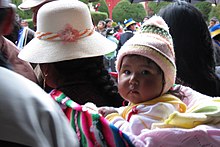Baby carrier



When carrying Ling is in mammals usually the - the type of the parents animals referred to a young animal, mother is carried about on a regular basis -. The classification as a baby relates to the behavior typical of the species , not to an individual situation.
The term tragling was coined in 1970 by Bernhard Hassenstein , who was unable to assign primates to nestlings or nest- fleders. He found that the primate cubs are in many ways similar to those who flee from the nest - they have fully developed eyes , ears and a coat of fur - but their limbs are not trained to move independently, but to cling to their mother's fur, which is what the hands do and feet give a bracket reflex ( Moro reflex ).
Passive and active carriers
Depending on the ability to hold on to the mother's skin, a distinction is made between passive and active babies.
Most marsupials have passive carriers . Here the young animals are poorly developed after only a short gestation period (pregnancy) and spend their first lifetime blindly and naked in their mother's pouch. Here they do not need to hold on to the maternal fur themselves, but are kept in the pouch. After all, a newborn kangaroo boy first has to crawl independently from the birth canal to the teat in the mother's pouch.
Active carriers, on the other hand, are born after a mostly long gestation period with already efficient sensory organs and full of hair. They hold on to the mother's fur in the area of the teats through the clinging reflex of the hands and feet or ride on the mother's back - especially with increasing child age. This group includes many tree -dwelling mammals, especially primates ( monkeys - also ground-dwelling species - tarsier ), anteaters and sloths .
With some species, such as the koalas , a phase as a passive baby is followed by a second phase as an active baby.
Man as a baby

A special case of the baby is the person whose baby is born after a long pregnancy with fully developed eyes and ears, but can only be carried passively in the arm or in a sling . The cling reflex is still present as a relic, but the mother also lacks a fur on which the child could hold on. Also, the infant's strength is not sufficient to permanently carry its own body weight. However, the infant is able to cling to the mother with both legs at waist level or later sitting on the hips, although he has to rely on the mother's support ( spread-squat position ). A typical characteristic of a baby is the lack of tolerance of a human infant to be left alone for a longer period of time.
Picture gallery
Active baby: The child of the common chimpanzee clings to the mother's fur and is suckled
Active support Ling: cub on the back of a mountain gorilla -Weibchens
Active baby carriers can also be carried passively by the parent animal: here a young gorilla in its mother's arms
literature
- Baby carrier . Lexicon of Biology , Spektrum Akademischer Verlag, Heidelberg 1999.
- Bernhard Hassenstein : Young animal and human child in the focus of comparative behavioral research . In: Reports of the Natural Science-Medical Association in Innsbruck. Volume 58, 1970, pp. 35-50.
Individual evidence
- ↑ Note on bernhard-hassenstein.de ( Memento from April 19, 2019 in the Internet Archive )


